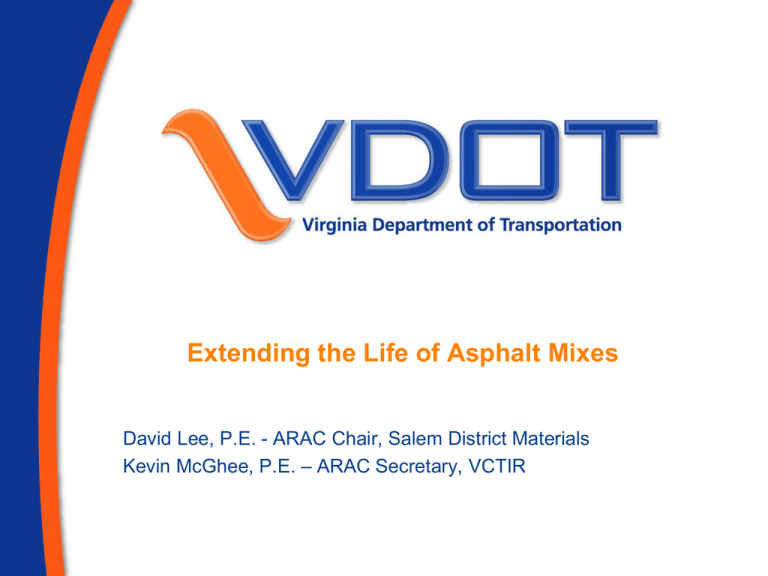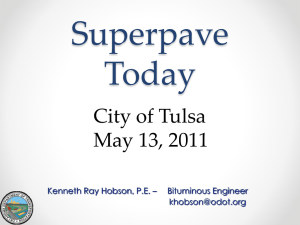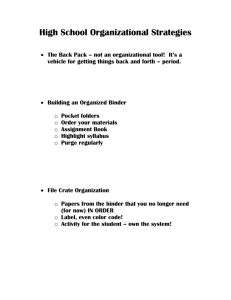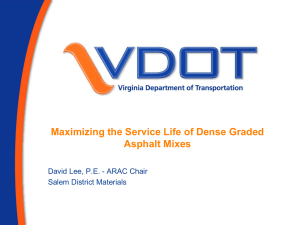Presentation 3 (Lee Mcghee), 2015 Regional Seminar - Superpave Mix Design Research
advertisement

Extending the Life of Asphalt Mixes David Lee, P.E. - ARAC Chair, Salem District Materials Kevin McGhee, P.E. – ARAC Secretary, VCTIR OUTLINE • • • • Background on Need for Research Study Results from Previous Research Project Phases Results from Latest Phase Potential Steps Forward in 2015 2 Background • There is a clear perception by both VDOT and Industry leaders that our present Superpave mixes do not have enough liquid asphalt content and, as such, are not lasting as long as they could. • This perception is supported by some recent data suggesting that our mixes are lasting 1-3 years less than previously determined. (McGhee/Clark) • There is a clear perception by both VDOT and Industry leaders that premature fatigue cracking due to low AC content is the reason for a significant amount of pavement failures around the state.” • 2010 Research Report by G. W. Maupin “Investigation of Optimized Mixture Design for Superpave Surface Mixtures” recommended additional research on the subject. 3 RESEARCH QUESTION • Are dense graded mixes designed with SUPERPAVE system providing consistently longer service life compared to previous mixes? • Criteria for Life • • • • Durable or Fatigue resistant Rutting resistant No flushing Skid resistant (surface mixes) • Research Objective – Maximize the service life of dense graded asphalt mixes PREVIOUS RESEARCH PHASE RESULTS Phase I – Superpave Designed Mix Analysis • Comparisons • Volumetrics for 50 and 65 Gyrations • Volumetric results for 50 and 75 blow Marshall • Mix gradations • Bag samples for future phases VTM – SM 9.5 Mixes Marshall Superpave 6 VMA – SM 9.5 Mixes Min. (Sup. & Marshall 7 RESULTS FROM PHASE I • VTM – Superpave Gyratory (SGC) produces approximately 2% lower VTM than the Marshall hammer. • VMA – SGC produces approximately 1-2% lower VMA than the Marshall hammer. • Review of the data did not produce a definitive “simple solution” (i.e., just reduce the number of gyrations). 8 LATEST PHASE RESULTS Sampled plant produced SM-9.5 mixes Targeted mixes with 23% or less passing #30 sieve and at least 58% passing #4 sieve Collected materials to do: 1. Determine AC content, gradation and volumetrics of Spec produced mixes 2. Determine VTM and VMA for mixes at 50 gyrations 3. Calculate binder needed to meet 3.5% VTM at 50 gyrations (new optimum AC) 4. Performance test initial mix, mix at optimum, mix at optimum plus 0.2% binder, and mix at optimum plus 0.4% binder 9 GRADATIONS FOR MIXES TESTED 10 VTM vs. Added Binder @ 50 Gyrations 6.5 Trial Added Asphalt Content for Branscome VTM at 50 Gyrations (%) 6 5.5 5 4.5 4 3.5 3 2.5 2 0 0.2 0.4 0.6 0.8 Added Binder Content (%) 1 1.2 11 VMA vs. Added Binder @ 50 Gyrations Trial Added Asphalt Content for Branscome VMA at 50 Gyrations (%) 19 18 17 16 15 14 13 0 0.2 0.4 0.6 0.8 Added Binder Content (%) 1 1.2 12 FLOW NUMBER vs. ADDED BINDER (VTM = 7%) 2500 Flow Number 2000 1607 1500 1450 1000 873 513 500 0 0 0.65 0.85 Added Binder Content (%) 1.05 13 FE INDEX vs. ADDED BINDER (VTM = 7%) Fracture Energy Index 10 9 8 7 6 5 4 3 2 1 0 0 0.65 0.85 Added Binder Content (%) 1.05 14 The Bottom Line • We know we need mixes that have a longer fatigue life to prolong the development of cracking. • We know we need to ensure that any added AC does not lead to rutting or bleeding. • We believe the aggregate gradations need to be tighter on certain sieves as well as the addition of one or more control sieves (#30 and #4) to combat mix tenderness and rutting. • Ensuring we have the AC content and gradation correct is even more critical with increasing use of RAP. 15 POTENTIAL NEXT STEPS • Finalize select use special provision for SM-9.5 with changes to: • • • • • • Solicit demonstration projects from across state Design and produce experimental mixes Pave control (65 gyrations and 4% VTM) and experimental mixes Retrieve mix (control and experimental) for additional lab performance testing • • • Design Gradations (#30 and #4 sieves) Design Gyrations (50) Flow Number and APA for rutting Fracture Energy for cracking Collect density data from control and experimental sites 16





